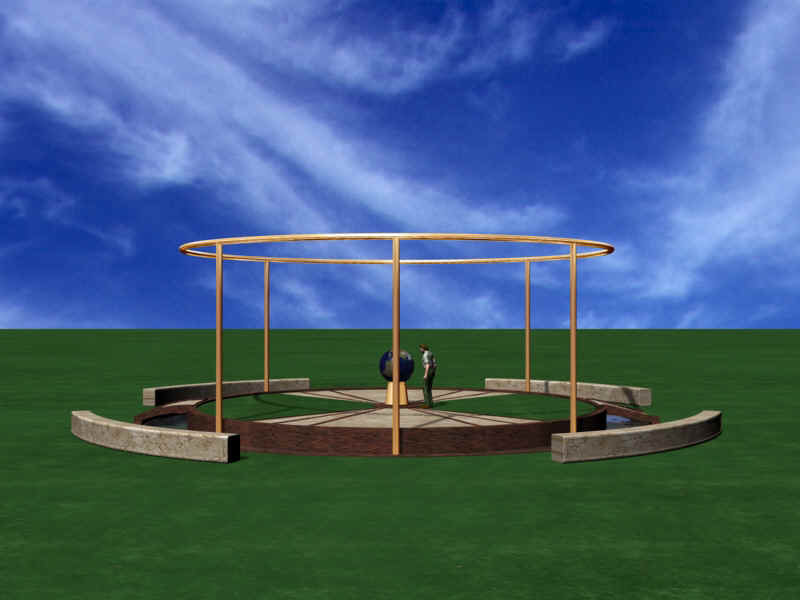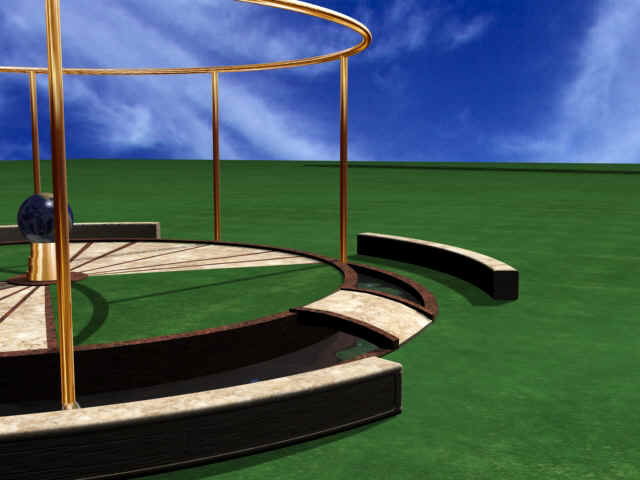SpaceHenge
by Bill Lauritzen
Heliocentric Education Tool and Earth Orbit Analog Tracking Computer
a link to the past
a tool for the present
a legacy for the future
"If you see the sun move, if you see it rise, or set, or move across the sky,
you are delusional. Spacehenge is designed to fix that.
At Stonehenge, the Sun goes round the Earth.
At Spacehenge, the Earth goes round the Sun."
Mass Delusions in Astronomy: Theoretical Background to Spacehenge
You are delusional. It is my duty to tell you this as a psychologist. In fact, you are part of a mass delusion that has gripped the globe. I would call it a delusion of the “grandiose type,” and unfortunately it has gone undetected for millennia.
Do not despair, your prognosis is good, and it is my intention to cure you and others of this delusion. It is my intention that you have seen your last “sunset.” For the sun doesn’t set, my friend.
Although you see the sun “come up” or “go down,” we have known for several hundred years, since about the time of Galileo in 1633, that THE SUN DOES NOT MOVE. (Some of you may know of galactic rotation and other motions which are of no concern to us here.) We live in a heliocentric not a geocentric system. If you see it move, if you see it rise or set or even travel across the sky, you are seeing something that is not possible. Hence my diagnosis of delusion. more...
The Spacehenge Ring: Theory and Models Stonehenge: World's First Computer Sketches
The central globe of Spacehenge is parallel to the real Earth and sits "piggyback" on it with Los Angeles on top for both of them. In this photo, we see the horizon-sun intersection for the real Earth as well as the piggyback globe. Because the distance to the center of the Earth is only 4,000 miles, which is minuscule compared to the 93,000,000 miles to the sun, this globe, with Los Angeles on top, gives the correct orientation of the Earth in Space to the Sun. We see that South America is in darkness. By examining the other parts of the globe, we can instantly see how any location would view the sun at that instant.
Artist’s Statement and Philosophy:
1) Art and science should work together to stimulate the growth of new cognitive models.
2) Art should emerge from the natural world and blend to some degree with the surrounding landscape. more...
Spacehenge Sculpture: Nickel-Aluminum-Bronze, with moat.

In this Spacehenge about half of the interior of the design is grass, so that people can relax, read, and eat lunch by the water. Around the north and south face of the circle are stone benches, integrated into the rest of the sculpture. These are also for relaxing and eating lunch, etc. Stone ramps lead across the moat from the south and north.
View from the East.

View from the East. Sunny day.
“Spacehenge is a ring, sitting on a spinning ball that is tilted in a fixed way as it rounds the Home Star.”
Bill Lauritzen, the designer

View from the East. Partly cloudy day.
“We need to finish the revolution begun by Aristarchus, Copernicus, and Galileo. We need to see the Earth spinning away from the home star, not the sun setting in the west…”
Bill Lauritzen, the designer

View from the Southeast, slightly elevated.

View from the South, slightly elevated.

View from the South, slightly elevated, sunny.

View from the South, ground level.
“We have all experienced sitting in an auto or train and having another vehicle nearby. We think the other vehicle is moving, but it turns out that we are moving. We are disoriented for a second while we transition to the correct orientation. Spacehenge is designed to facilitate this transition for humanity and the Sun-Earth System.”
Bill Lauritzen, the designer
 image by Jason Lysinger
image by Jason Lysinger
View from the top, mid-morning. North is above.
“I observed that Homo sapiens is too often disconnected from the environment
that first stimulated the rise of mathematics and science...”
Bill Lauritzen, the artist

Man looking at Northwest Pacific Ocean.

South section of the monument, showing bridge and benches.

View from the Southwest, early morning.

View from the Southwest, mid-morning.
Key Features:
-
Base Ring.
-
Raised Ring.
-
Brown Orbital Lines
-
Two Green Illuminated Lines.
-
Six Orbital Poles.
-
Parallel Earth Globe.
-
Biologically Active Moat.
-
Cognitive Readjustment Plaque (not shown).
It has a water-filled Moat with fish. Coming up out of the Moat are Six Orbital Poles, all connected by a Raised Ring. The Six Orbital Poles rising up out of the water represent the emergence of life from the oceans and the resulting biological diversification that eventually led to humans, whom eventually created Stonehenge and this Spacehenge design.
In the very center of the circle of poles is a Globe with Los Angeles (or any city) at the top, with its north oriented towards the true north. If this Globe were in the center of the Earth it would exactly parallel the real Earth. However, since the distance to the center of the Earth is miniscule compared to the distance to the home star and the other stars, the globe gives the viewer the correct perspective for where and how the Earth is situated in relation to the these other bodies! This perspective allows the human viewer to see and experience (perhaps for the first time) that the Earth is spinning and that the sun doesn't "set" or "rise!"
Materials will include stainless steel, marble, quartz, granite, and concrete. For the most strength, probably the poles and upper ring will be stainless steel as in the very first image.
At the outer edge of circle of poles, Two Green Illuminated Lines (shown above, one for "sunrise," one for "sunset"), under hard glass, mark the current Earth's orbital points ("sunset" or "sunrise" intersection points, for an unobstructed horizon) as Earth travels through space around the home star. In this rendering, the Two Green Illuminated Lines show that it is either Feb 21st or Oct 21st. The other Brown Orbital Lines mark the Dec 21, Jan 21 (Nov 21), Mar 21 (Sep 21), Apr 21 (Aug 21), May 21 (Jul 21), and Jun 21 orbital points of the Earth throughout its orbit. When the Two Green Illuminated Lines match one of the dates above (Brown Orbital Lines), then it would gently pulsate at the rate of once per second. This pulsation marks the above dates.
Very subtle and soft night lighting (not shown) would come up from the ground level. This would allow a view of the brightest stars and planets at night. This night lighting would commence each day at the exact time of the "sunset," and then turn off at "sunrise."
The Heliocentric Education Plaque
A Plaque near the south entrance to the design (not shown in this rendering) would be an important feature. This Plaque is designed to change the faulty model in our brains of the Earth-Sun system. This Heliocentric Education Plaque would read:
Spacehenge Monument
Artist: Bill Lauritzen
The sun does not rise or set, or shift along the horizon as the year progresses. Because of the tilt of the Earth from upright as it 1) spins, and 2) rounds the home star, the base ring (and the concentric ring of the horizon) intersect the home star at different points.
The marker on the base ring shows the current base ring intersection points, as the Earth spins to and spins away from the home star, and thus also shows the current orbital location of the Earth. The brown lines mark the base ring intersection points for the four traditional orbital points (the 2 solstices and 2 equinoxes) and the monthly intervals (or orbital points) between them.
The orientation of the central globe matches the Earth's position in space. Because the distance to the center of the Earth is miniscule compared to the distance to the home star and the other stars, this central globe demonstrates the relative position of the Earth to these other bodies.
Shadows that strike the globe from the poles are the same as shadows that would strike Earth, if all of Spacehenge were expanded so that the globe matched the size of the real Earth.
In sum, Spacehenge is a ring, sitting on a spinning Earth that is tilted in a fixed way as it rounds the Home Star.
| traditional | scientific |
|---|---|
| sunset | spin out |
| sunrise | spin in |
| spring equinox | orbital point 1 |
| summer solstice | orbital point 2: max tilt in |
| fall equinox | orbital point 3 |
| winter solstice | orbital point 4: max tilt-out |
(Directly under this would be a map something like this:)
Orbital Point 2: Max Tilt-In: Summer Solstice
Orbital Point 4: Max Tilt-Out: Winter Solstice
Orbital Point 2: Max Tilt-In: Summer Solstice.
Interdisciplinary Monument
-
the orbital poles, lines, and marks,
-
the parallel-Earth globe, piggy-backed on the real Earth
-
a biologically active moat, and
-
the cognitive readjustment plaque, would effectively merge the physical sciences, the biological sciences, the social sciences, and the humanities.